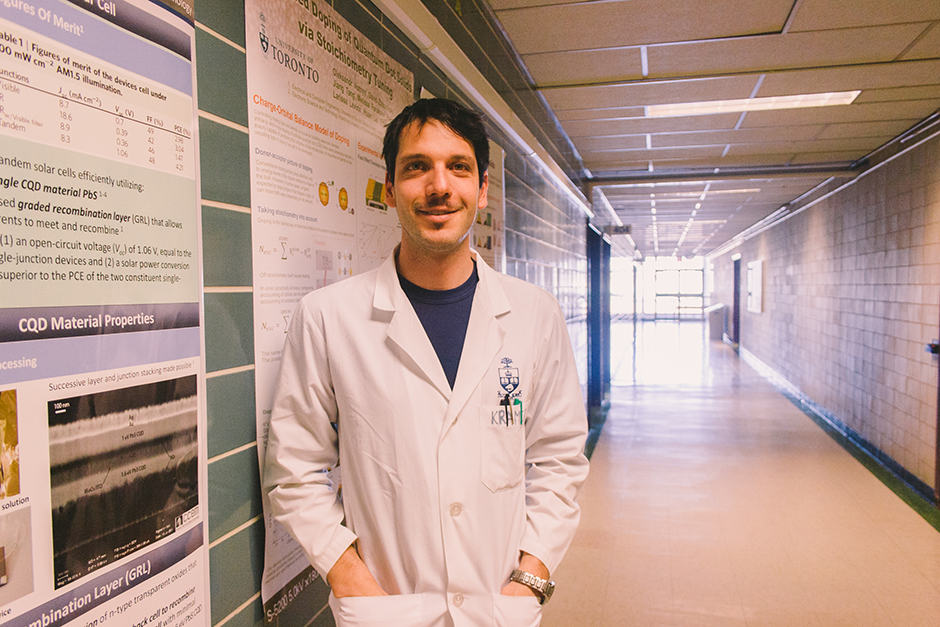The Sargent group, a research team headed by Dr. Edward Sargent, has made strides in the field of photovoltaics and nanoscience. Their research has improved the efficiency of solar cells by harvesting light from previously inaccessible regions of the solar spectrum.
The Varsity spoke with Dr. Illan Kramer, a postdoctoral researcher in the group, to discuss the group’s work and his personal vision for the future of solar energy.
The Varsity: What makes you so passionate about studying renewable energy?
Illan Kramer: I actually worked for a few years in a tech company in the Boston area. [It was a] big tech company that was… very set in its ways… but it was very not nimble. When an issue arose, it was kind of like turning a battleship. There was a lot of paper pushing needed… to make changes happen. It was around that time, after a couple of years of working there, that I realized I wanted to work somewhere… where I had more control over the day-to-day work that I do… So that’s why I went back to grad school… in renewable energy specifically, because I think energy is a big problem that’s facing the world [right] now but mostly in the coming decades. I’m hoping I can be a part of the solution.
TV: How would you describe the field of nanoscience in non-scientific terms?
IK: When you go from working with bulk materials to working with nanomaterials, there comes a sort of threshold in terms of some critical dimension where the material stops behaving like that material. If you can imagine [that] you’re holding a piece of iron, for example, iron behaves [the same way] at a metre long, or half a metre long, or a centimetre long. But once you keep reducing that critical dimension down to a certain point, usually somewhere on the nanoscale, it stops behaving like iron and starts behaving like something else. What we work with is a material called lead sulphide… Once we reduce the size of the lead sulphide to something in the neighbourhood of three to five nanometers, [it] starts behaving quite differently. [It] starts absorbing different wavelengths of light. [Its] electrical properties begin to shift as well. We take advantage of those differences to make, in our case, solar cells tailored to the applications that we want.
TV: How has the Sargent Group contributed to the field of photovoltaics?
IK: Photovoltaics is a… well-established field, dominated largely by materials like crystals and silicon. Those are the panels that you’ll see on people’s roofs or in a big solar farm… One of the things that solar cells can’t do is harvest sunlight in the infrared portion of the sun spectrum. Silicon does a very good job of absorbing visible light and a little bit of infrared light, but there is still a lot of light that the sun emits that silicon cannot absorb. So we work with materials that can absorb infrared light; mainly with quantum dots, which are… nanometre-sized crystals that float in solution so the solution looks like a dark ink. When we spin-coat, or spray-coat, or dip-coat the solution onto a substrate, we get a really dark film that is capable of absorbing both visible light and infrared light, which are the parts of the solar spectrum that silicon can’t absorb. Our biggest contribution is basically being able to access parts of the solar spectrum that were previously inaccessible by conventional materials.
TV: What is a current research problem or topic of interest for the Sargent group?
IK: We are always looking at: one, making our solar cells more efficient, and two, making them more [easily manufactured]. On the efficiency front, the best quantum-dot solar cells that have ever been published are about 8.5 [to] 8.6 per cent — they [were] recently published by an MIT research group. We have solar cells that perform just about as well. Between us and a handful of other research groups… we have always been among the leaders — if not the leader — in the field. But, 8.5 per cent is interesting scientifically, but it’s not interesting commercially, yet. If you want to make a solar cell that you think can realistically be put up on somebody’s roof or out in a solar farm, out in a field, you are going to need to be much more efficient than that. So this is one of our constant focuses — making more efficient solar cells. One advantage we have is that our materials are much cheaper than [those in] conventional silicon solar panels. We’re sort of operating on this paradigm that… if we’re half as efficient as silicon but we cost one per cent as much as silicon, then maybe we’re economically interesting.
TV: Do you expect solar energy to be the solution to the energy crisis?
IK: If you look at all of the numbers, it seems like solar energy is the only long-term solution. If you assume that one day we will exhaust everything that is buried in the ground, the sun hopefully will always be shining on the earth. We will always have that energy… for ‘free.’ That sunlight is going to land on the earth’s surface all the time, it’s very plentiful. [Only a small amount of land would be needed to capture enough energy to power a large population]. You could be very efficient at harvesting sunlight and turning it into power for the whole world. In the more immediate term, realistically, it’s not going to be our biggest source of energy, but it should be an increasingly large part of our energy supply, because eventually, we are just going to run out of new sources of natural gas or coal or other [sources of power]. And as it becomes cheaper and cheaper, there’s no reason not to use it.
This interview has been edited and condensed for clarity and length.


